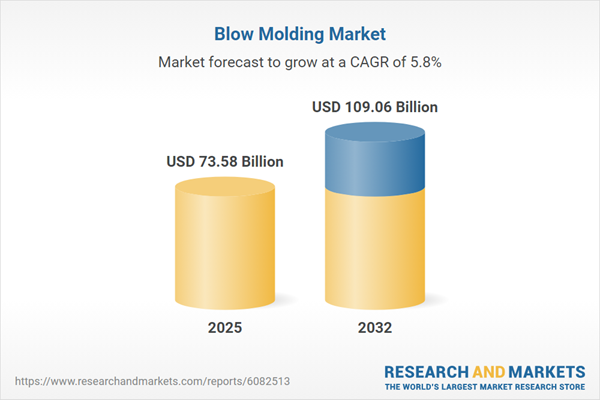Speak directly to the analyst to clarify any post sales queries you may have.
The global blow molding market is evolving rapidly as advanced materials, manufacturing automation, and changing end-use requirements converge to reshape production standards and value chains. Senior leaders navigating this sector face mounting pressures to modernize operations, boost resilience, and deliver both efficiency and sustainability.
Market Snapshot: Blow Molding Market Growth and Outlook
The blow molding market grew from USD 69.50 billion in 2024 to USD 73.58 billion in 2025, with continued expansion projected at a 5.79% CAGR to USD 109.06 billion by 2032. This sustained growth reflects high demand for lightweight, high-performance polymer components across packaging, automotive, and industrial sectors. Modernization initiatives and regulatory requirements drive adoption of advanced extrusion, injection, and stretch blow molding technologies while suppliers diversify feedstock sources and refine recyclability strategies.
Scope & Segmentation
- Container Types: Automotive components, bottles (including HDPE, PET, and PP bottles), containers and drums (large, medium, small), tanks and IBCs, technical articles and components
- Material Types: HDPE, PET, PP, PVC
- Machine Types: Extrusion blow molding, injection blow molding, stretch blow molding
- End-Use Industries: Automotive, consumer goods, food & beverage, industrial, pharmaceutical & healthcare
- Regions Covered: Americas (United States, Canada, Mexico, Brazil, Argentina, Chile, Colombia, Peru), Europe, Middle East & Africa (United Kingdom, Germany, France, Russia, Italy, Spain, Netherlands, Sweden, Poland, Switzerland, United Arab Emirates, Saudi Arabia, Qatar, Turkey, Israel, South Africa, Nigeria, Egypt, Kenya), Asia-Pacific (China, India, Japan, Australia, South Korea, Indonesia, Thailand, Malaysia, Singapore, Taiwan)
- Profiles of Key Companies: Amcor PLC, Berry Global Group, Plastipak Holdings, ALPLA Werke Alwin Lehner, Graham Packaging, Huhtamaki Oyj, Nampak Limited, Greiner Packaging, Faerch A/S, Resilux NV
Key Takeaways for Industry Leaders
- Integration of advanced process controls and digital manufacturing solutions reduces defects, stabilizes throughput, and accelerates turnaround for high-mix operations.
- Circularity mandates and customer sustainability expectations are compelling manufacturers to certify recyclate-compatible resins and implement closed-loop supply models.
- Regional policies and differences in energy costs, labor models, and regulatory standards shape distinct capital investment and automation strategies by geography.
- Competitive differentiation is increasingly tied to technical expertise, engineered services, and resilient supply agreements that address complex requirements in packaging, healthcare, and automotive applications.
- Manufacturers that align machine technology, material selection, and quality assurance practices are better positioned to capture premium contracts in regulated sectors.
Tariff Impact on Sourcing, Operations, and Design
Tariff interventions implemented in 2025 have substantially shifted the strategic landscape for blow molding manufacturers and buyers. These interventions have driven organizations to reevaluate supplier networks, prioritize diversification, and develop robust qualification programs for alternative feedstocks. The emphasis on localizing operations and tightening yield management has become critical for margin protection. Moreover, cross-functional collaboration on product redesign and disciplined cost oversight help offset increased import expenses and stabilize operational resilience in a changing regulatory context. Contract renegotiation and granular scenario planning now underlie decision-making across procurement and finance teams.
Methodology & Data Sources
This market report employs a rigorous mixed-methods framework. The research synthesizes primary insights from plant managers, procurement leaders, and engineering specialists through structured interviews and site observations. These inputs are combined with technical literature, standards documentation, and scenario analysis to validate findings, ensuring practical and actionable recommendations. Cross-functional workshops ensure the relevance and defensibility of strategic options for blow molding industry decision-makers.
Why This Report Matters
- Enables executives to align investments in modernization, sourcing resilience, and sustainability with core growth opportunities.
- Clarifies how circularity regulations, regional dynamics, and new tariffs directly impact procurement, production, and customer partnerships.
- Offers reliable, stakeholder-driven insights to inform strategy development, capital allocation, and risk management for senior leaders.
Conclusion
The blow molding sector is at a pivotal point, with modernization, material stewardship, and supply chain realignment central to long-term viability. Leaders who act decisively and integrate operational, material, and contractual strategies will secure sustained advantage in evolving market conditions.
Table of Contents
3. Executive Summary
4. Market Overview
7. Cumulative Impact of Artificial Intelligence 2025
Companies Mentioned
The companies profiled in this Blow Molding market report include:- Amcor PLC
- Berry Global Group, Inc.
- Plastipak Holdings, Inc.
- ALPLA Werke Alwin Lehner GmbH & Co KG
- Graham Packaging Company, Inc.
- Huhtamaki Oyj
- Nampak Limited
- Greiner Packaging International GmbH
- Faerch A/S
- Resilux NV
Table Information
| Report Attribute | Details |
|---|---|
| No. of Pages | 180 |
| Published | November 2025 |
| Forecast Period | 2025 - 2032 |
| Estimated Market Value ( USD | $ 73.58 Billion |
| Forecasted Market Value ( USD | $ 109.06 Billion |
| Compound Annual Growth Rate | 5.7% |
| Regions Covered | Global |
| No. of Companies Mentioned | 11 |









